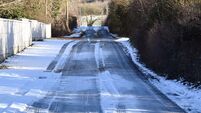Water down the drain, and money too
We just turn a tap and expect clean, potable water to pour forth. There may be nothing more important to life, but do we give it a second thought? Ensuring that people have a regular supply of water that’s safe to drink is a challenge for the Government and local authorities. Ireland is in danger of failing to meet EU water quality challenges.
That’s saying nothing about cost and wastage. Our ailing and leaking supply system gets just 57% of all treated drinking water to our taps, while 43% is lost in delivery. This compares badly with losses of between a tenth and a quarter for our European neighbours.
At a time when cost-cutting is priority, this is money, pardon the pun, going down the drain. The national pipe network that is haemorrhaging millions of gallons of water every day is old and in need of replacement. It is essential that we have reliable systems and procedures to ensure the public has confidence in its drinking water. That confidence has been dented by reports of contaminated water, notably in Galway, where cryptosporidium created a crisis in 2007. The water issue, one of the most crucial, got a good airing at a recent conference in Dublin organised by the National Standards Authority of Ireland (NSAI) and Engineers Ireland. Maurice Buckley, chief executive of NSAI, said the shaking of public confidence in water supplies was not a bad thing. People feel entitled to safe drinking water, and crises arising from contamination lead them to ask questions, all of which helps create an understanding that water is not an infinite resource, or something that can be squandered or taken for granted.
Many are now questioning government policy, or their drinking-water suppliers, and that can only put positive pressure on those charged with providing us with safe water. It should be seen as an ‘early warning alert’ for those responsible to doubly focus on the issues at hand, before other, more serious incidents occur.
Mr Buckley said: “It is, therefore, essential we have systems and procedures in place to ensure that the public can rely on their drinking water, and that effective and sustainable approaches for the management of our drinking water supply are improved upon.’ John Power, director general, Engineers Ireland, which represents 24,000 engineers, said continued investment in our water infrastructure should be a priority in order to maintain this resource. This is important in relation to population growth, climate change and environmental management.
The EPA conducts 240,000 monitoring tests annually on 952 public water supplies, 830 public group water schemes, 588 private group water schemes and 888 small private supplies. The EPA can prosecute local authorities in cases of a failure to comply with a direction concerning a public water-supply system.
Ruth Barrington, of the EPA’s Office of Environmental Enforcement, told the conference improvements had been reported since the EPA began to use its extra powers – a decrease in E.coli exceedance, for example.
The 14-member water enforcement team deals with quality and safety issues, regarding drinking water, on a regional basis. However, she said additional investment and operational improvements were needed to develop a system that would provide Ireland with clean, safe drinking water for the future.
The water industry, as a whole, is highly fragmented, with 29 county councils and more than 5,500 group schemes providing Irish consumers with their drinking water.
NSAI is urging local authorities, county councils, and other water suppliers, to consider implementing standards as part of their service strategy. Such an approach would enable benchmarking against best international practice.
Much work has been done and improvements have been made. The Government has promised to invest significantly in upgrading and developing our water infrastructure.
The National Development Plan has earmarked €4.7bn investment in modernising our water services. Most of our drinking water comes from rivers and lakes, but 26% of the supply comes from ground water, or springs.
Ground water is the water that trickles through the soil and into underlying rocks, filtering slowly. It seeps up and emerges at ground level by coming out at springs, or flowing into rivers.
Ground water is not usually subjected to treatment, but monitoring networks are in place to check that purity levels are in accordance with drinking water standards. The EPA uses a selection of public and private wells and springs, countrywide, for monitoring.
Contamination of ground water can be caused by seepage of farm waste, poorly-operating septic tanks and leaching of water soluble plants nutrients from soil.














